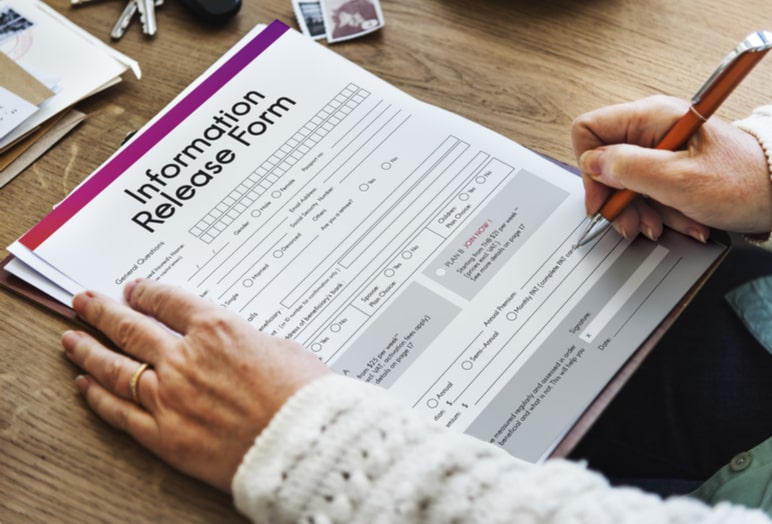
10 Jul Unlocking the Secrets: Filling Out Your Release of Information Form
How to fill out a release of information form might seem daunting, but it’s easier than you think, especially with just a few key steps. To help Lisa, and anyone in similar shoes, steer this, it’s crucial to break down what a release of information form is and how it connects with HIPAA as well as patient information.
In the busy corridors of health management and legal professions, gaining access to medical records in a seamless, efficient manner is essential. These forms are the gateways to obtaining protected health information (PHI) while ensuring compliance with privacy laws like HIPAA. They empower patients to control their data, specifying what information is shared, with whom, and for what duration.
By understanding these forms and the role they play, professionals like Lisa can save time and effort, focusing on what really matters—pushing cases forward without the constant hassle of administrative hiccups. This introduction will guide you through the basics, setting the stage for a deeper dive into the mechanics of filling out a release of information form efficiently and error-free.
Understanding the Release of Information Form
A release of information form is a crucial document in healthcare and legal settings. It allows patients to control who can access their personal health information. Let’s break down some key elements of this form to make it simple and straightforward.
Patient Information
First, you need to provide patient information. This includes the patient’s full name, date of birth, and medical record number (MRN) or patient identification number (PIN). This ensures that the correct records are being accessed. If you don’t know the MRN or PIN, don’t worry—you can ask your healthcare provider for it.
Clinic Details
Next, identify the clinic or healthcare provider that holds the records you want to release. Include the provider’s full name, address, phone number, and secure fax or email. Accurate clinic details help in locating the right records without unnecessary delays.
Purpose of Release
The purpose of release section is where you specify why you want the information shared. Common reasons include ongoing care, transferring to a new doctor, or for legal purposes. While HIPAA doesn’t require you to fill this section, providing a reason can sometimes speed up the process.
“I give authorization for the health information detailed above in this document to be disclosed to the following individual(s) or organization(s).”
This statement clarifies your consent for sharing your health data.
By understanding these components, you can fill out the form accurately, ensuring your medical information is shared as you intend. This not only helps you comply with HIPAA regulations but also streamlines the process for everyone involved.
Now that we have a grasp of the form’s basic structure, let’s move on to the step-by-step guide for filling it out.
How to Fill Out a Release of Information Form
Filling out a release of information form might seem daunting, but with a little guidance, it can be straightforward. Here’s a step-by-step guide to help you through the process and avoid common pitfalls.
Step-by-Step Guide
- Patient Identification
Start by entering the patient’s full name, date of birth, and medical record number (MRN) or patient identification number (PIN). This ensures the right records are accessed. If you don’t have the MRN or PIN, contact your healthcare provider to get it. - Receiving Party
Clearly specify who will receive the information. This could be a doctor, a healthcare facility, or even yourself. Include the recipient’s full name, address, phone number, and secure email or fax. If you need to send records to multiple parties, you may need separate forms. - Expiration Date
Decide how long the authorization should be valid. You can set a specific date or event after which the authorization expires. If left blank, the release typically expires in 6 months to a year. This gives you control over how long your information can be shared. - Signature and Date
Sign and date the form to confirm your consent. Without your signature, the form is invalid. This step is crucial, as missing it will halt the process entirely. - Legal Authority
If you are not the patient, specify your relationship to the patient and provide legal documentation that authorizes you to act on their behalf. This might include power of attorney or guardianship papers.
Common Mistakes to Avoid
- Incorrect Information
Double-check all details to ensure they’re correct. Errors in names, dates, or contact information can delay or invalidate the request. - Incomplete Forms
Make sure every required section is filled out. Missing information, like an unsigned form or an unspecified expiration date, can lead to rejection of the request. - Ignoring Legal Authority
If you’re acting on behalf of someone else, failing to provide the necessary legal documents can stop the process. Always attach copies of any required legal paperwork.
By following these steps and avoiding common mistakes, you can ensure a smooth and efficient process when filling out a release of information form. Now, let’s explore the key components of the form in more detail.
Key Components of the Form
When you’re filling out a release of information form, understanding its key components is crucial. Let’s break down each part to make it easier for you to complete.
Patient Information Section
This section is all about identifying the patient whose records are being requested. Here’s what you’ll need:
- Full Name: Write the patient’s full legal name. This helps ensure there are no mix-ups with other patients.
- Date of Birth: Adding the date of birth provides another layer of identification, ensuring the correct records are released.
- Medical Record Number (MRN): This unique number is assigned by the healthcare provider and is critical for locating the right records. If you don’t know it, contact your provider to get it.
Clinic and Provider Details
Next, you’ll need to provide information about the healthcare provider or facility that holds the records:
- Provider Name: Include the full name of the clinic, hospital, or healthcare provider. This ensures the request is directed to the right place.
- Contact Information: Add the provider’s address, phone number, and any other relevant contact details. This helps in case there are any questions about the request.
- Secure Email or Fax: Many providers prefer to send records electronically for security and speed. Make sure to provide a secure email or fax number where the records can be sent.
Information to be Released
Specify what information you need. This could be anything from specific test results to entire medical histories. Be precise to avoid unnecessary delays.
Release Instructions
Indicate how and when you want the information delivered. You might prefer electronic copies, paper records, or even specific delivery dates. Providers typically have up to 30 days to comply.
Relationship to Patient
If you’re filling out the form for someone else, describe your relationship to the patient. Are you a parent, guardian, or legal representative? Make sure to attach any legal documents that confirm your authority, like power of attorney papers.
By understanding these components, you can complete the form accurately and efficiently. This ensures that your request is processed without any hitches. Next, we’ll tackle some frequently asked questions about filling out a release of information form.
Frequently Asked Questions about Filling Out a Release of Information Form
When it comes to filling out a release of information form, you might have some questions. Let’s address the most common ones to make the process smoother for you.
What is Required on a Release Form?
To properly fill out a release form, several key elements must be included:
- Signature: The most critical part. The patient or their legal representative must sign the form to authorize the release of information. Without this, the form is invalid.
- Purpose: While not always mandatory, specifying why the information is being released can be helpful. Common purposes include ongoing care, legal proceedings, or personal use.
- Expiration Date: Every release form needs an expiration date or event. This ensures the authorization is not open-ended. For example, you might set it to expire one year after signing or after a specific treatment ends.
How Long is the Release Valid?
The duration of consent depends on what you specify in the form:
- Expiration Date: Clearly state when the authorization should expire. This could be a specific date or an event, like the end of treatment.
- Duration of Consent: If you don’t specify, many forms default to a standard period, often six months to a year. Always check with your provider to confirm their policy.
Can I Leave Sections Blank?
Some sections of the form might be optional, but others are required under HIPAA rules:
- HIPAA Rules: Patient name, signature, and expiration details are non-negotiable. These ensure the release is legally binding and respects privacy laws.
- Optional Sections: You may leave sections like the purpose of release blank if it’s not required by your provider. However, filling it out can prevent misunderstandings.
Understanding these aspects of the release form helps you avoid delays and ensures your request is processed smoothly. With this knowledge, you’re ready to complete your form with confidence.
Conclusion
Filling out a release of information form might seem daunting, but with a clear understanding of the process, it becomes straightforward. At American Retrieval, we aim to make this task even easier with our exceptional service and commitment to accuracy.
Our team is dedicated to ensuring that your medical record retrieval is seamless. We integrate with client databases to provide real-time updates, so you’re never left wondering about the status of your request. Plus, our simple and affordable pricing means helps ensure you get the service you deserve without unnecessary costs.
Whether you’re a legal professional or part of the clinical industry, our services are designed to meet your needs efficiently. Our presence in major cities like St. Paul, Chicago, Dallas, Atlanta, and San Francisco allows us to serve a broad range of clients across the nation.
For more information on how we can assist you with medical records retrieval, visit our Medical Records Retrieval Service. Let us help you open up the secrets of your release of information form with ease and expertise.



